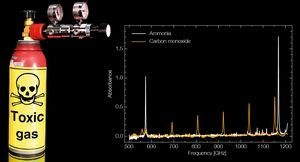Gas Sensing with a Frequency-Domain Terahertz Platform
One terahertz system – a multitude of gases
- Numerous gases show terahertz “fingerprints”
- One terahertz system identifies a large number of gases
- Detection even works through black smoke
- Recommended system: TeraScan
Identification of individual gases
Many polar gas molecules possess distinct transitions in the terahertz frequency range. At standard pressure, their linewidths appear pressure-broadened to a few GHz, but at low pressures these absorption lines narrow to single-MHz widths. This opens the possibility to identify individual gases by their terahertz “fingerprint”. Whilst gas sensing works in the near-infrared part of the spectrum, too, available lasers offer a limited tuning range, and each gas species may require an individual laser setup. Unique benefits of cw-terahertz spectroscopy include chemical specificity (a single system detects a large number of gases), large bandwidth, MHz-level resolution, and the ability to monitor “inaccessible” settings, such as flames and black smoke.
Two application scenarios are industrial process control, and threat detection in public institutions. Demands are high: A monitoring system in a subway station must unambiguously identify hazardous substances in a cluttered background of cleaning agents, glues, engine fumes and paint.
-
Related Products
-
Related Applications
-
Related Literature
Related Literature
- Review paper: Naftaly, M., et al., Industrial applications of terahertz sensing: State of play, Sensors (2019)
- Publication: A. Deninger et al., 2.75 THz tuning with a triple-DFB laser system at 1550 nm and InGaAs photomixers; J Infrared Milli. Terahz. Waves 36:3 (2015)
- Publication: D. Stanze et al., Compact cw terahertz spectrometer pumped at 1.5 nm wavelength; J Infrared Milli. Terahz. Waves 32:2 (2011)
- Publication: A. Roggenbuck et al., Coherent broadband continuous-wave terahertz spectroscopy on solid-state samples; New J. Phys. 12 (2010)
- Article: M. Lang, et al., Laser-based terahertz generation & applications, Photonik International (2014)
- Downloads

